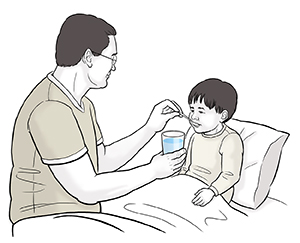What to Do When Your Child Is Vomiting
When your child throws up (vomits), it’s normal to be concerned or worried. But vomiting is usually not due to a major health problem. Vomiting is most often caused by a virus or food poisoning. It often lasts only 1 or 2 days. The main concern when your child is vomiting is that they will lose too much fluid and become dehydrated. This sheet tells you what you can do to help your child feel better and stay hydrated.
How is vomiting treated at home?
Stomach rest. Keep your child from eating or drinking for 30 to 60 minutes after vomiting. This gives your child’s stomach a chance to recover.
Replacing fluids. Dehydration can be a problem when your child is vomiting. Start replacing fluids after your child hasn't vomited for 30 to 60 minutes. To do this:
Start by giving your child very small amounts (1/2 oz or less) of fluid every 5 to 10 minutes. Use a teaspoon instead of a glass to give fluids.
Use an oral rehydration solution, water, or another clear, noncarbonated liquid. Breast milk may be given if your child is breastfeeding. You can try to breastfeed more frequently and for a shorter time.
If your child vomits the fluid, wait at least another 30 minutes. Then start again with a very small amount of fluid every 5 to 10 minutes.
If your child is having trouble swallowing, offer frozen juice bars (without pieces of fruit) or ice chips.
Stay away from sports drinks, fruit juice, and other drinks with high sugar content. They do not have the right levels of sugar and electrolytes.
Solid food. If your child is hungry and asking for food, try giving small amounts of bland food. This includes crackers, dry cereal, rice, or noodles. Avoid giving your child greasy, fatty, or spicy foods for a few days as your child recovers.
Medicines. If your child has a fever, ask your doctor if you can give an over-the-counter medicine, such as acetaminophen. If your child cannot keep the medicine down, ask your pharmacist about getting the medicine in suppository form. Don’t give your child aspirin to relieve a fever. Using aspirin to treat a fever in children could cause a serious condition called Reye syndrome. Also, ibuprofen isn't approved for infants under 6 months of age.
If the vomiting doesn't stop, your doctor may prescribe medicine to help with upset stomach and vomiting.
When to contact your child's doctor
Contact your child's doctor right away if:
Your child is vomiting and has a severe headache or a very stiff neck.
Your child has a fever (see "Fever and children" below).
Your child vomits several times an hour for a few hours.
Vomiting gets worse or does not improve within 24 hours.
Your child's vomit is bloody or greenish.
Your child has belly pain or tenderness.
Your child's body keeps trying to throw up, but there isn't any vomit. (This is called retching or dry heaves.)
Your child has very forceful vomiting.
Your child has bloody diarrhea.
Your child has symptoms of dehydration, such as:
Sleeping much more than usual, or being hard to wake up.
No pee for 6 to 8 hours, or very dark pee.
Refusing fluids for 6 to 8 hours.
Dry mouth, sunken eyes, or a lack of tears.
Fever and children
Use a digital thermometer to check your child’s temperature. Don’t use a mercury thermometer. There are different kinds and uses of digital thermometers. They include:
Rectal. For children younger than 3 years old, a rectal temperature is the most accurate.
Forehead (temporal). This works for children age 3 months and older. If a child under 3 months old has signs of illness, this can be used for a first pass. The doctor may want to confirm with a rectal temperature.
Ear (tympanic). Ear temperatures are accurate after 6 months of age, but not before.
Armpit (axillary). This is the least reliable but may be used for a first pass to check a child of any age with signs of illness. The doctor may want to confirm with a rectal temperature.
Mouth (oral). Don’t use a thermometer in your child’s mouth until they are at least 4 years old.
Use the rectal thermometer with care. Follow the product maker’s directions for correct use. Insert it gently. Label it and make sure it’s not used in the mouth. It may pass on germs from the stool. If you don’t feel okay using a rectal thermometer, ask the doctor what type to use instead. When you talk with any health care provider about your child’s fever, tell them which type you used.
Below are guidelines to know if your young child has a fever. Your child’s doctor may give you different numbers for your child. Follow your doctor’s specific instructions.
Fever readings for a baby under 3 months old:
First, ask your child’s doctor how you should take the temperature.
Rectal or forehead: 100.4°F (38°C) or higher
Armpit: 99°F (37.2°C) or higher
Fever readings for a child age 3 months to 36 months (3 years):
Rectal, forehead, or ear: 102°F (38.9°C) or higher
Armpit: 101°F (38.3°C) or higher
Contact the doctor in these cases:
Repeated temperature of 104°F (40°C) or higher in a child of any age
Fever of 100.4°F (38°C) or higher in baby younger than 3 months
Fever that lasts more than 24 hours in a child under age 2
Fever that lasts for 3 days in a child age 2 or older
